Welcome Unit Discovering Useful Structures 课件(共27张PPT)-2025-2026学年人教版(2019)第一册
文档属性
| 名称 | Welcome Unit Discovering Useful Structures 课件(共27张PPT)-2025-2026学年人教版(2019)第一册 | 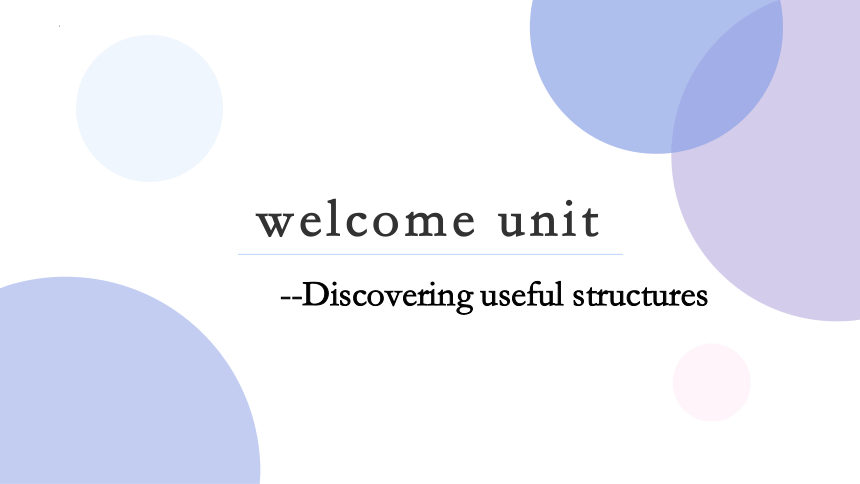 | |
| 格式 | pptx | ||
| 文件大小 | 387.0KB | ||
| 资源类型 | 教案 | ||
| 版本资源 | 人教版(2019) | ||
| 科目 | 英语 | ||
| 更新时间 | 2025-07-16 18:14:10 | ||
图片预览

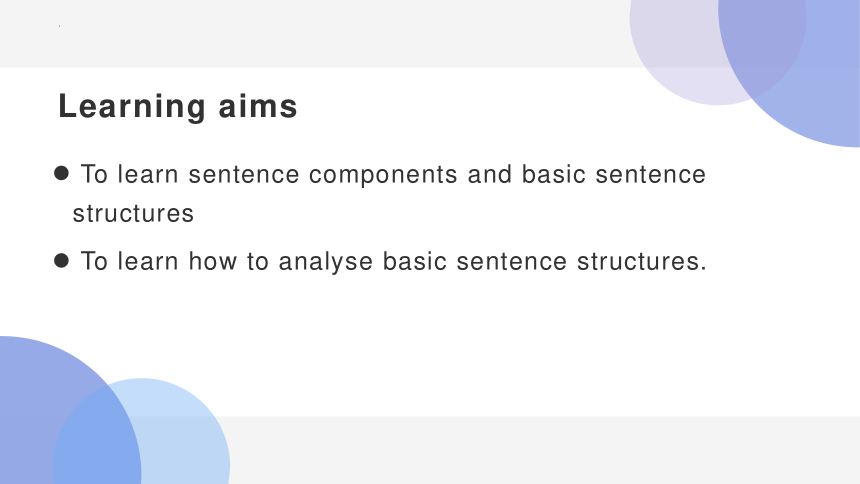
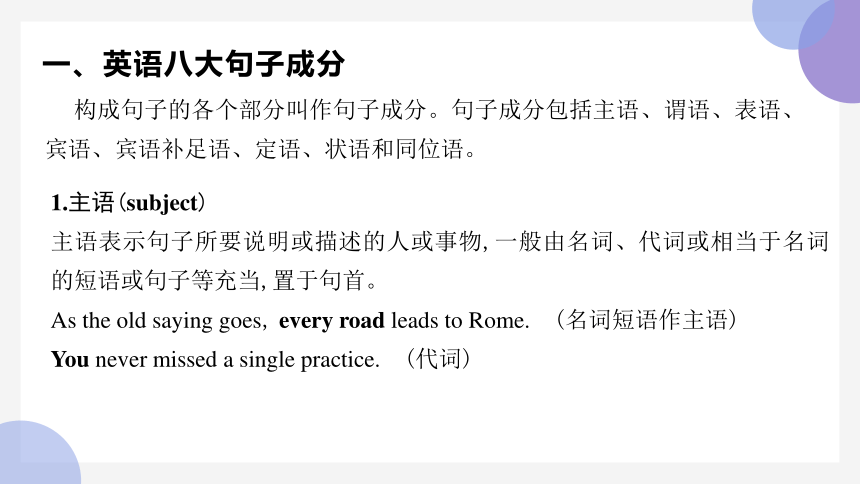

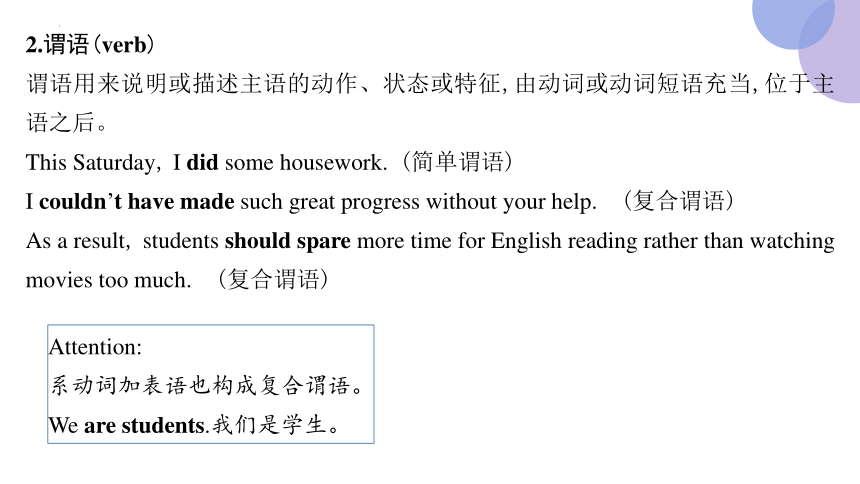
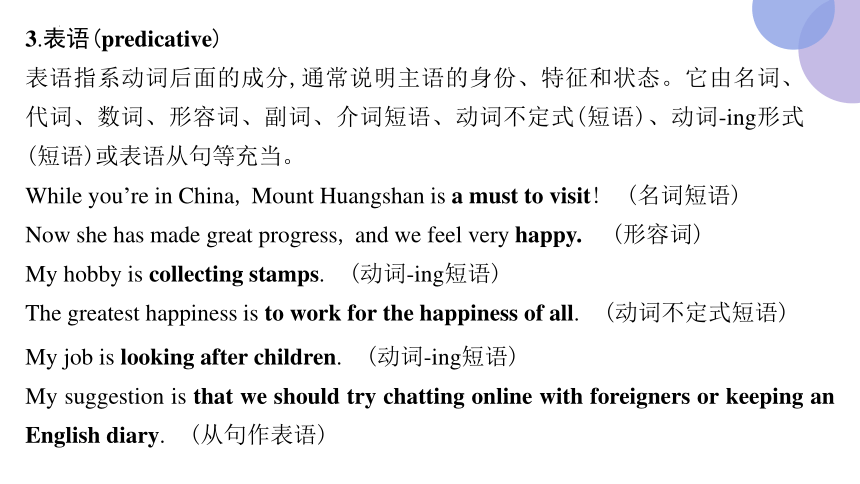
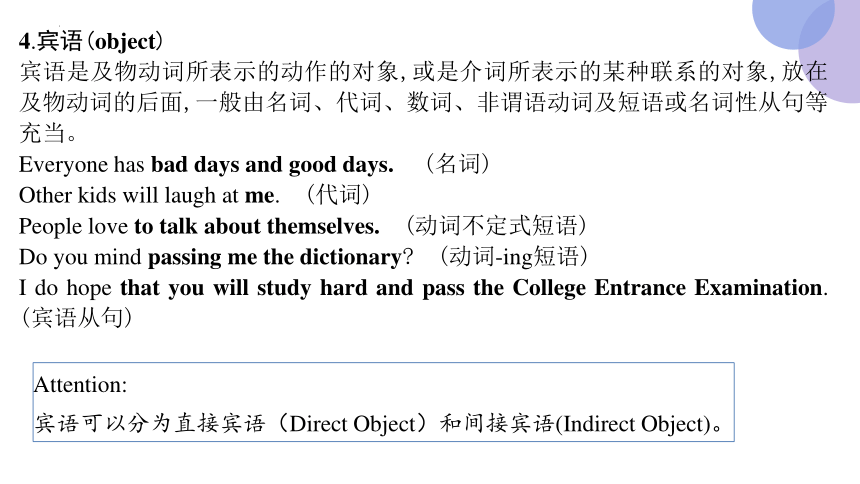
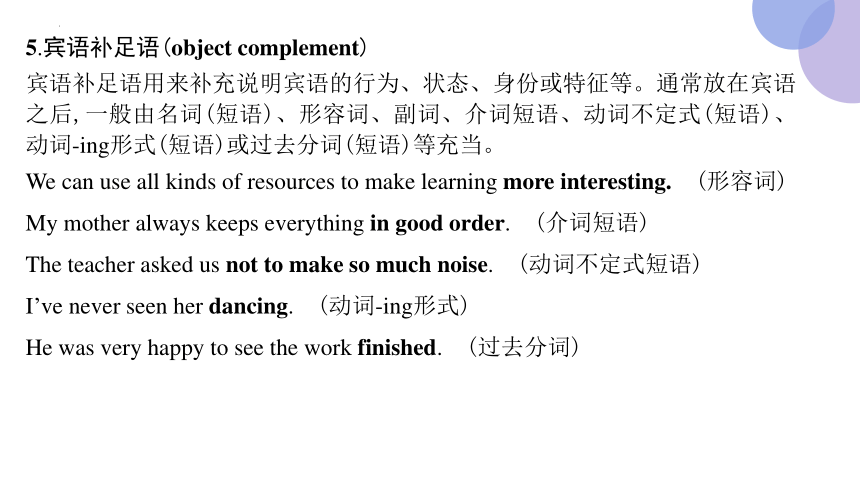
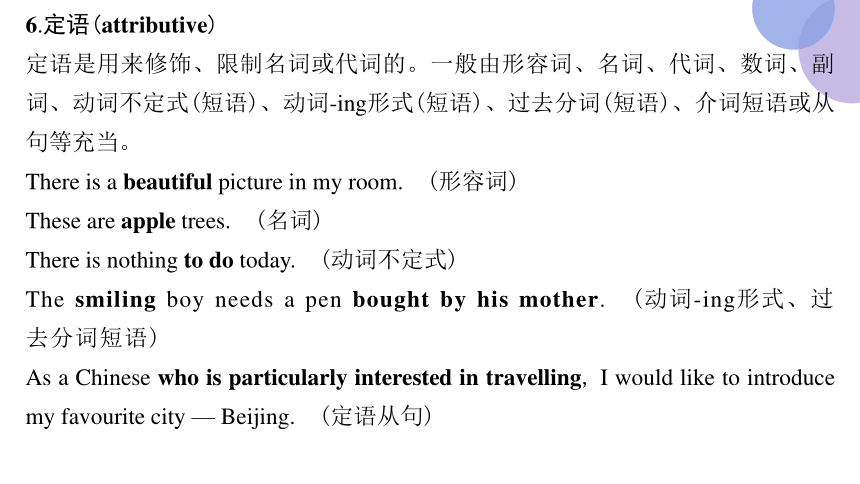
文档简介
(共27张PPT)
welcome unit
--Discovering useful structures
Learning aims
To learn sentence components and basic sentence structures
To learn how to analyse basic sentence structures.
一、英语八大句子成分
构成句子的各个部分叫作句子成分。句子成分包括主语、谓语、表语、宾语、宾语补足语、定语、状语和同位语。
1.主语(subject)
主语表示句子所要说明或描述的人或事物,一般由名词、代词或相当于名词的短语或句子等充当,置于句首。
As the old saying goes, every road leads to Rome. (名词短语作主语)
You never missed a single practice. (代词)
To see is to believe. (动词不定式)
Keeping a diary is a good way to practise writing. (动词-ing短语)
What troubles me most is that it’s difficult for me to enjoy a good sleep every night. (主语从句)
2.谓语(verb)
谓语用来说明或描述主语的动作、状态或特征,由动词或动词短语充当,位于主语之后。
This Saturday, I did some housework. (简单谓语)
I couldn’t have made such great progress without your help. (复合谓语)
As a result, students should spare more time for English reading rather than watching movies too much. (复合谓语)
Attention:
系动词加表语也构成复合谓语。
We are students.我们是学生。
3.表语(predicative)
表语指系动词后面的成分,通常说明主语的身份、特征和状态。它由名词、代词、数词、形容词、副词、介词短语、动词不定式(短语)、动词-ing形式(短语)或表语从句等充当。
While you’re in China, Mount Huangshan is a must to visit! (名词短语)
Now she has made great progress, and we feel very happy. (形容词)
My hobby is collecting stamps. (动词-ing短语)
The greatest happiness is to work for the happiness of all. (动词不定式短语)
My job is looking after children. (动词-ing短语)
My suggestion is that we should try chatting online with foreigners or keeping an English diary. (从句作表语)
4.宾语(object)
宾语是及物动词所表示的动作的对象,或是介词所表示的某种联系的对象,放在及物动词的后面,一般由名词、代词、数词、非谓语动词及短语或名词性从句等充当。
Everyone has bad days and good days. (名词)
Other kids will laugh at me. (代词)
People love to talk about themselves. (动词不定式短语)
Do you mind passing me the dictionary (动词-ing短语)
I do hope that you will study hard and pass the College Entrance Examination. (宾语从句)
Attention:
宾语可以分为直接宾语(Direct Object)和间接宾语(Indirect Object)。
5.宾语补足语(object complement)
宾语补足语用来补充说明宾语的行为、状态、身份或特征等。通常放在宾语之后,一般由名词(短语)、形容词、副词、介词短语、动词不定式(短语)、动词-ing形式(短语)或过去分词(短语)等充当。
We can use all kinds of resources to make learning more interesting. (形容词)
My mother always keeps everything in good order. (介词短语)
The teacher asked us not to make so much noise. (动词不定式短语)
I’ve never seen her dancing. (动词-ing形式)
He was very happy to see the work finished. (过去分词)
6.定语(attributive)
定语是用来修饰、限制名词或代词的。一般由形容词、名词、代词、数词、副词、动词不定式(短语)、动词-ing形式(短语)、过去分词(短语)、介词短语或从句等充当。
There is a beautiful picture in my room. (形容词)
These are apple trees. (名词)
There is nothing to do today. (动词不定式)
The smiling boy needs a pen bought by his mother. (动词-ing形式、过去分词短语)
As a Chinese who is particularly interested in travelling, I would like to introduce my favourite city — Beijing. (定语从句)
7.状语(adverbial)
状语用于修饰动词、形容词、副词或整个句子。
一般由副词、形容词、动词不定式(短语)、动词-ing形式(短语)、过去分词(短语)、介词短语、独立主格或从句等充当。
To the researchers’ surprise, the disease was spreading more rapidly than expected. (副词)
Hearing my words, he finally made up his mind to run. (动词-ing短语)
When the house was built, it was much smaller than it is today. (状语从句)
8.同位语(appositive)
若两个语法单位指同一个人或事物,并且句法功能也一样,那么,后一项称为前一项的同位语。
We human beings should well protect our oceans for the following reasons.
Professor Wang, a famous scientist, will give us a talk tomorrow.
Exercises:
写出下列句中画线部分所作的句子成分:
①The manager made them work day and night. 宾语补足语
②I hope you will find these suggestions practical. 宾语补足语
③Keeping healthy is very important for us. 主语;表语
④I’ll go and pick you up at your place. 谓语;地点状语
⑤We should try to put ourselves in their shoes. 宾语;定语
宾语补足语
宾语补足语
主语;表语
谓语;地点状语
宾语;定语
二、八种基本句型
1.主语+谓语(S+V)
这种句型结构中的谓语动词为不及物动词(短语),其后不能直接跟宾语,也没有被动语态。主谓结构常用来表示主语的动作或状态。 常见的不及物动词(短语)有rise、 matter、 begin、 come、 go、 happen、 appear、 work、 come true、
All of us lsughed!
The sun is rising.
The little boy is crying.
2.主语+谓语+宾语(S+V+O)
(1)这种句型结构中的谓语动词必须是及物动词(短语),一般有被动语态。用作宾语的有名词、代词、数词、动词不定式、动词-ing形式或从句等。
I miss my grandma.
David won a medal for his great courage.
注:在“动词+介词”的动词短语中,宾语只能放在介词之后;在“动词+副词”的动词短语中,作宾语的名词放于副词前后皆可;代词只能放在副词之前。
Please wake Li Ling up (=wake up Li Ling) at 6:30 in the morning.( √ )
Please wake her up at 6:30 in the morning.( √ )
Please wake up her at 6:30 in the morning.( × )
√
√
×
3.主语(+系动词)+表语(S+P)
这种句型结构中的谓语动词为系动词,无被动语态,也无进行时态。表语由名词、形容词、介词短语、分词、动词不定式或从句充当。
The teacher was kind and friendly.
She looked a littled annoyed.
He become an English teacher.
系动词一览表:
状态系动词 be
表象系动词 look, appear, seem
感官系动词 (look) feel, smell, sound, taste
持续系动词 keep, remain, stay, hold, continue, last, lie, stand,
变化系动词 become, get, grow, turn, go, fall, come, run
终止系动词 prove, turn out
4.主语+谓语+间接宾语+直接宾语(S+V+IO+DO)
这种句型结构中的及物动词后跟双宾语,指人的宾语称为间接宾语,指物的宾语称为直接宾语。通常间接宾语在前,直接宾语在后,也可把间接宾语置于直接宾语后,但间接宾语前需用介词for或to。
间接宾语之前用介词to的常见动词有give、 tell、 teach、 write、 bring、 lend、 hand、 show、 offer、 send、 pay、 order等。
He told me a funny story.= He told a funny story to me.
间接宾语之前用介词for的常见动词有buy、 fetch、 save、 choose、 sing等。
She bought me a birthday present.= She bought a birthday present for me.
5.主语+谓语+宾语+宾语补足语(S+V+O+C)
该句型结构中的宾语补足语可以由名词、形容词、副词、介词短语或非谓语动词等充当。该句型常用于三类动词:
(1)使役动词:keep、 make、 let、 have、 leave、 get等;
Her words make me happy.
(2)感官动词或短语:see、 watch、 notice、 observe、 find、 catch、 hear、 feel、 smell、 look at、 listen to等;
I found most of my classmates and teachers friendly and helpful.
(3)其他动词:ask、 tell、 order、 request、 permit、 persuade 等。
Mike told me not to go.
6.主语+谓语+状语(S+V+A)
该句型结构中的谓语通常为不及物动词;副词或介词短语在句中作状语,修饰或说明谓语。
He talked too much.
The time passed quickly.
7.主语+谓语+宾语+状语(S+V+O+A)
该句型结构中的谓语通常为及物动词;副词或介词短语在句中作状语,修饰或说明谓语。
I had my first maths class at senior high school.
8.There be句型
There be句型表示某处存在某物或某人,基本结构为“There is/are/was/were ...+地点状语”。谓语动词有时可用表示存在的其他动词,如live、 stand、 lie、 seem/appear to be (好像有)、 happen to be (碰巧有)、 used to be (曾经有) 等。
There’s a lot to explore at senior high school.
There is a piano in my study.
There are 56 students in my class.
①This kind of food tastes terrible. S+P
②He studies hard. S+V+A
③There are many places of interest worth visiting. There be句型
④He made me very angry. S+V+O+C
⑤I visited many places of interest with my family last week. S+V+O+A
⑥Tom will bring me several English books tomorrow. S+V+IO+DO
S+P
S+V+A
There be句型
S+V+O+C
S+V+O+A
S+V+IO+DO
写出下列句子所属的句型结构
Exercises:
Exercises:
Read the sentences and analyse the structures.
The 100-year-old school lies in the centre of the city .
We must act.
The maths home work looks easy.
The teacher found the classroom empty.
My mum bought me a new dictionary.
Tom is looking forward to meeting the new exchange student.
There is an English Corner at our school.
We had chemistry in the newly built lab.
S+V+A
S+V
S+V+P
S+V+O+C
S+V+IO+DO
S+V+O
There be
S+V+O+A
Analyse the structures of the underlined sentences.
How would you like to go to school and travel the world at the same time For Tim, that dream has come true! This term, Tim and his classmates are living on a ship! They take the same subjects as you do, like maths and English. They also learn about ships and the sea. Tim writes his parents an email every week and tells them what happened on the ship. Tim loves living on the ship. There’s always something exciting to do. Ands, after a long day of study, he likes to watch the sun go down and wait for the stars to come out. Studying and doing homework seem much more fun when you are at sea!
Exercises:
that dream has come true.( )
Tim and his classmates are living on a ship.( )
They also learn about ships and the sea.( )
Tim writes his parents an email every week and tells them what happened on the ship. ( )
There’s always something exciting to do. ( )
Studying and doing homework seem much more fun. ( )
that dream has come true.( S+V )
Tim and his classmates are living on a ship.( S+V+A )
They also learn about ships and the sea.( S+V+O )
Tim writes his parents an email every week and tells them what happened on the ship. ( S+V+IO+DO )
There’s always something exciting to do. ( There be )
Studying and doing homework seem much more fun. ( S+V+P )
Thank you !
welcome unit
--Discovering useful structures
Learning aims
To learn sentence components and basic sentence structures
To learn how to analyse basic sentence structures.
一、英语八大句子成分
构成句子的各个部分叫作句子成分。句子成分包括主语、谓语、表语、宾语、宾语补足语、定语、状语和同位语。
1.主语(subject)
主语表示句子所要说明或描述的人或事物,一般由名词、代词或相当于名词的短语或句子等充当,置于句首。
As the old saying goes, every road leads to Rome. (名词短语作主语)
You never missed a single practice. (代词)
To see is to believe. (动词不定式)
Keeping a diary is a good way to practise writing. (动词-ing短语)
What troubles me most is that it’s difficult for me to enjoy a good sleep every night. (主语从句)
2.谓语(verb)
谓语用来说明或描述主语的动作、状态或特征,由动词或动词短语充当,位于主语之后。
This Saturday, I did some housework. (简单谓语)
I couldn’t have made such great progress without your help. (复合谓语)
As a result, students should spare more time for English reading rather than watching movies too much. (复合谓语)
Attention:
系动词加表语也构成复合谓语。
We are students.我们是学生。
3.表语(predicative)
表语指系动词后面的成分,通常说明主语的身份、特征和状态。它由名词、代词、数词、形容词、副词、介词短语、动词不定式(短语)、动词-ing形式(短语)或表语从句等充当。
While you’re in China, Mount Huangshan is a must to visit! (名词短语)
Now she has made great progress, and we feel very happy. (形容词)
My hobby is collecting stamps. (动词-ing短语)
The greatest happiness is to work for the happiness of all. (动词不定式短语)
My job is looking after children. (动词-ing短语)
My suggestion is that we should try chatting online with foreigners or keeping an English diary. (从句作表语)
4.宾语(object)
宾语是及物动词所表示的动作的对象,或是介词所表示的某种联系的对象,放在及物动词的后面,一般由名词、代词、数词、非谓语动词及短语或名词性从句等充当。
Everyone has bad days and good days. (名词)
Other kids will laugh at me. (代词)
People love to talk about themselves. (动词不定式短语)
Do you mind passing me the dictionary (动词-ing短语)
I do hope that you will study hard and pass the College Entrance Examination. (宾语从句)
Attention:
宾语可以分为直接宾语(Direct Object)和间接宾语(Indirect Object)。
5.宾语补足语(object complement)
宾语补足语用来补充说明宾语的行为、状态、身份或特征等。通常放在宾语之后,一般由名词(短语)、形容词、副词、介词短语、动词不定式(短语)、动词-ing形式(短语)或过去分词(短语)等充当。
We can use all kinds of resources to make learning more interesting. (形容词)
My mother always keeps everything in good order. (介词短语)
The teacher asked us not to make so much noise. (动词不定式短语)
I’ve never seen her dancing. (动词-ing形式)
He was very happy to see the work finished. (过去分词)
6.定语(attributive)
定语是用来修饰、限制名词或代词的。一般由形容词、名词、代词、数词、副词、动词不定式(短语)、动词-ing形式(短语)、过去分词(短语)、介词短语或从句等充当。
There is a beautiful picture in my room. (形容词)
These are apple trees. (名词)
There is nothing to do today. (动词不定式)
The smiling boy needs a pen bought by his mother. (动词-ing形式、过去分词短语)
As a Chinese who is particularly interested in travelling, I would like to introduce my favourite city — Beijing. (定语从句)
7.状语(adverbial)
状语用于修饰动词、形容词、副词或整个句子。
一般由副词、形容词、动词不定式(短语)、动词-ing形式(短语)、过去分词(短语)、介词短语、独立主格或从句等充当。
To the researchers’ surprise, the disease was spreading more rapidly than expected. (副词)
Hearing my words, he finally made up his mind to run. (动词-ing短语)
When the house was built, it was much smaller than it is today. (状语从句)
8.同位语(appositive)
若两个语法单位指同一个人或事物,并且句法功能也一样,那么,后一项称为前一项的同位语。
We human beings should well protect our oceans for the following reasons.
Professor Wang, a famous scientist, will give us a talk tomorrow.
Exercises:
写出下列句中画线部分所作的句子成分:
①The manager made them work day and night. 宾语补足语
②I hope you will find these suggestions practical. 宾语补足语
③Keeping healthy is very important for us. 主语;表语
④I’ll go and pick you up at your place. 谓语;地点状语
⑤We should try to put ourselves in their shoes. 宾语;定语
宾语补足语
宾语补足语
主语;表语
谓语;地点状语
宾语;定语
二、八种基本句型
1.主语+谓语(S+V)
这种句型结构中的谓语动词为不及物动词(短语),其后不能直接跟宾语,也没有被动语态。主谓结构常用来表示主语的动作或状态。 常见的不及物动词(短语)有rise、 matter、 begin、 come、 go、 happen、 appear、 work、 come true、
All of us lsughed!
The sun is rising.
The little boy is crying.
2.主语+谓语+宾语(S+V+O)
(1)这种句型结构中的谓语动词必须是及物动词(短语),一般有被动语态。用作宾语的有名词、代词、数词、动词不定式、动词-ing形式或从句等。
I miss my grandma.
David won a medal for his great courage.
注:在“动词+介词”的动词短语中,宾语只能放在介词之后;在“动词+副词”的动词短语中,作宾语的名词放于副词前后皆可;代词只能放在副词之前。
Please wake Li Ling up (=wake up Li Ling) at 6:30 in the morning.( √ )
Please wake her up at 6:30 in the morning.( √ )
Please wake up her at 6:30 in the morning.( × )
√
√
×
3.主语(+系动词)+表语(S+P)
这种句型结构中的谓语动词为系动词,无被动语态,也无进行时态。表语由名词、形容词、介词短语、分词、动词不定式或从句充当。
The teacher was kind and friendly.
She looked a littled annoyed.
He become an English teacher.
系动词一览表:
状态系动词 be
表象系动词 look, appear, seem
感官系动词 (look) feel, smell, sound, taste
持续系动词 keep, remain, stay, hold, continue, last, lie, stand,
变化系动词 become, get, grow, turn, go, fall, come, run
终止系动词 prove, turn out
4.主语+谓语+间接宾语+直接宾语(S+V+IO+DO)
这种句型结构中的及物动词后跟双宾语,指人的宾语称为间接宾语,指物的宾语称为直接宾语。通常间接宾语在前,直接宾语在后,也可把间接宾语置于直接宾语后,但间接宾语前需用介词for或to。
间接宾语之前用介词to的常见动词有give、 tell、 teach、 write、 bring、 lend、 hand、 show、 offer、 send、 pay、 order等。
He told me a funny story.= He told a funny story to me.
间接宾语之前用介词for的常见动词有buy、 fetch、 save、 choose、 sing等。
She bought me a birthday present.= She bought a birthday present for me.
5.主语+谓语+宾语+宾语补足语(S+V+O+C)
该句型结构中的宾语补足语可以由名词、形容词、副词、介词短语或非谓语动词等充当。该句型常用于三类动词:
(1)使役动词:keep、 make、 let、 have、 leave、 get等;
Her words make me happy.
(2)感官动词或短语:see、 watch、 notice、 observe、 find、 catch、 hear、 feel、 smell、 look at、 listen to等;
I found most of my classmates and teachers friendly and helpful.
(3)其他动词:ask、 tell、 order、 request、 permit、 persuade 等。
Mike told me not to go.
6.主语+谓语+状语(S+V+A)
该句型结构中的谓语通常为不及物动词;副词或介词短语在句中作状语,修饰或说明谓语。
He talked too much.
The time passed quickly.
7.主语+谓语+宾语+状语(S+V+O+A)
该句型结构中的谓语通常为及物动词;副词或介词短语在句中作状语,修饰或说明谓语。
I had my first maths class at senior high school.
8.There be句型
There be句型表示某处存在某物或某人,基本结构为“There is/are/was/were ...+地点状语”。谓语动词有时可用表示存在的其他动词,如live、 stand、 lie、 seem/appear to be (好像有)、 happen to be (碰巧有)、 used to be (曾经有) 等。
There’s a lot to explore at senior high school.
There is a piano in my study.
There are 56 students in my class.
①This kind of food tastes terrible. S+P
②He studies hard. S+V+A
③There are many places of interest worth visiting. There be句型
④He made me very angry. S+V+O+C
⑤I visited many places of interest with my family last week. S+V+O+A
⑥Tom will bring me several English books tomorrow. S+V+IO+DO
S+P
S+V+A
There be句型
S+V+O+C
S+V+O+A
S+V+IO+DO
写出下列句子所属的句型结构
Exercises:
Exercises:
Read the sentences and analyse the structures.
The 100-year-old school lies in the centre of the city .
We must act.
The maths home work looks easy.
The teacher found the classroom empty.
My mum bought me a new dictionary.
Tom is looking forward to meeting the new exchange student.
There is an English Corner at our school.
We had chemistry in the newly built lab.
S+V+A
S+V
S+V+P
S+V+O+C
S+V+IO+DO
S+V+O
There be
S+V+O+A
Analyse the structures of the underlined sentences.
How would you like to go to school and travel the world at the same time For Tim, that dream has come true! This term, Tim and his classmates are living on a ship! They take the same subjects as you do, like maths and English. They also learn about ships and the sea. Tim writes his parents an email every week and tells them what happened on the ship. Tim loves living on the ship. There’s always something exciting to do. Ands, after a long day of study, he likes to watch the sun go down and wait for the stars to come out. Studying and doing homework seem much more fun when you are at sea!
Exercises:
that dream has come true.( )
Tim and his classmates are living on a ship.( )
They also learn about ships and the sea.( )
Tim writes his parents an email every week and tells them what happened on the ship. ( )
There’s always something exciting to do. ( )
Studying and doing homework seem much more fun. ( )
that dream has come true.( S+V )
Tim and his classmates are living on a ship.( S+V+A )
They also learn about ships and the sea.( S+V+O )
Tim writes his parents an email every week and tells them what happened on the ship. ( S+V+IO+DO )
There’s always something exciting to do. ( There be )
Studying and doing homework seem much more fun. ( S+V+P )
Thank you !
